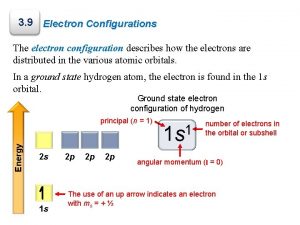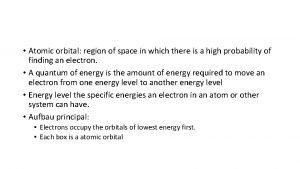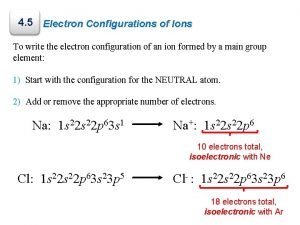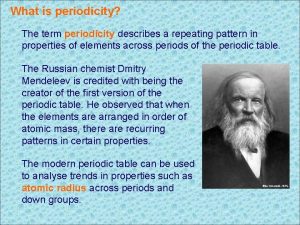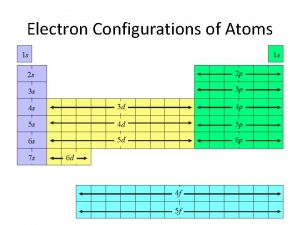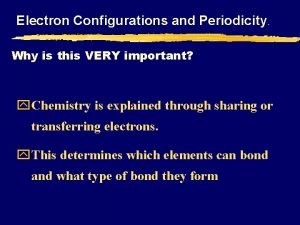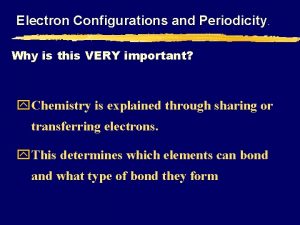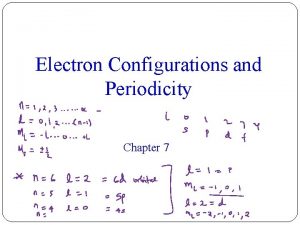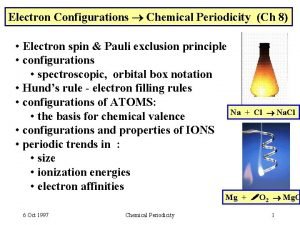Electron Configurations and Periodicity Why is this VERY














- Slides: 14

Electron Configurations and Periodicity. Why is this VERY important? y Chemistry is explained through sharing or transferring electrons. y This determines which elements can bond and what type of bond they form

How are the electrons arranged in an atom? What orbitals are preferentially filled by electrons? y What is an electron configuration?

Energy levels and sublevels y Energy levels (refer to periods on periodic table) y Also referred to as “shells” y 7 energy levels 1, 2, 3, 4 … 7 y Energy level 1 is lowest in energy and closest to the nucleus C. Johannesson

Sub-levels y The main energy levels contain sub-levels (refer to groups on periodic table #1 -18) y The different main energy levels have different sub-levels in them y There are four types based on shape of orbitals: s (groups 1 -2) lowest energy , p, (13 -18) d (transition metals), f (inner transition metals) highest energy C. Johannesson

Electrons in Atoms Electron Configuration C. Johannesson

3 RULES FOR THE ARRANGEMENT OF ELECTRONS IN ATOMS. Hints for rules z 1) The Pauli Exclusion Principle (not allowed) z 2) The Aufbau Principle (building up or Lazy tenant rule) z 3) Hund’s Rule (empty bus seat rule) C. Johannesson

A. General Rules z. Pauli Exclusion Principle y. Each orbital can only hold TWO electrons with opposite spins. y. No 2 electrons in the same atom can have the same set of all 4 quantum numbers (electrons can not occupy same space nor have the same spin) Right Wrong

General Rules: Aufbau Principle y. Electrons fill the lowest energy orbitals first. y(means building-up in German) in the ground state, the electrons will fill the atomic orbital of lowest energy first; “Lazy Tenant C. Johannesson Rule”

A. General Rules z. Hund’s Rule y. Within a sublevel, place one electron per orbital before pairing them. y“Empty Bus Seat Rule” WRONG C. Johannesson RIGHT

B. Notation z. Orbital Diagram O 8 e- 1 s 2 s z. Electron Configuration 2 2 4 1 s 2 s 2 p C. Johannesson 2 p

B. Notation z. Longhand Configuration S 16 e 6 2 2 2 1 s 2 s 2 p 3 s Core Electrons 4 3 p Valence Electrons Outermost electrons in highest enrgy level C. Johannesson

C. Periodic Patterns s p 1 2 3 4 5 6 7 f (n-2) d (n-1) 6 7 © 1998 by Harcourt Brace & Company C. Johannesson

C. Periodic Patterns z. Period # yenergy level (subtract for d & f) z. Group # ytotal # of valence ez. Column within sublevel block y# of e- in sublevel C. Johannesson

C. Periodic Patterns z. Example - Hydrogen 1 st column of s-block 1 1 s 1 st Period s-block C. Johannesson
 Electron configurations and periodicity
Electron configurations and periodicity Orbital diagram for k
Orbital diagram for k Orbital diagram for ca
Orbital diagram for ca Calcium ion formula
Calcium ion formula Stable electron configurations are likely to contain
Stable electron configurations are likely to contain An orbital is a region of space in an atom where there is
An orbital is a region of space in an atom where there is Electron configuration with ions
Electron configuration with ions Stable electronic configuration
Stable electronic configuration Pictures
Pictures Ap chemistry atomic structure and periodicity
Ap chemistry atomic structure and periodicity Oxygen periodic trends
Oxygen periodic trends Chapter 7 atomic structure and periodicity
Chapter 7 atomic structure and periodicity What is periodicity?
What is periodicity? Texas health steps quick reference guide
Texas health steps quick reference guide Feeding periodicity adalah
Feeding periodicity adalah


